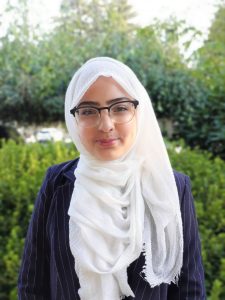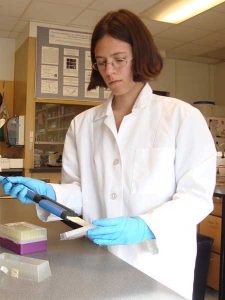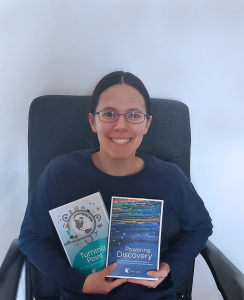
 By: Ardin Sacayanan, Undergraduate Student, Laksman Lab (left) & Kisa Naqvi, Undergraduate Student, Tropini Lab (right)
By: Ardin Sacayanan, Undergraduate Student, Laksman Lab (left) & Kisa Naqvi, Undergraduate Student, Tropini Lab (right)
This series aims to shine a spotlight on different CBR alumni and their career journeys after the CBR. We were so pleased to share the story of Dr. Katharine Sedivy-Haley.
Are you a CBR alum who wants to share your experiences, connect with the CBR, or have your profile featured? Email the CBR’s Education Program Manager, Dr. Parvin Bolourani (parvin@mail.ubc.ca).

Dr. Katharine (Kate) Sedivy-Haley
A non-linear path in life is sometimes key to opening many unexpected opportunities. This is the case for Dr. Katharine (Kate) Sedivy-Haley, a PhD alum of the Centre for Blood Research (CBR). Dr. Sedivy-Haley recently graduated from the PhD program for microbiology and immunology at the University of British Columbia. At the time of the interview, Dr. Sedivy-Haley was a Researcher at the Council of Canadian Academics (CCA); she is currently a Policy Advisor at Innovation, Science, and Economic Development Canada (ISED).
We had the opportunity to chat with Dr. Sedivy-Haley about her journey through grad school and her experience with career exploration, as well as her transition from academia into science policy.
How did you choose your PhD topic?

Dr. Katharine Sedivy-Haley in the lab
My original project examined macrophage polarization and innate defense regulator peptides, a topic that the Hancock lab has been studying for some time. These synthetic peptides are similar to natural peptides that regulate macrophage immune function. Originally, we planned to investigate the mechanisms behind this regulation by studying gene knockout macrophages derived from stem cells, but ran into complications.
Around this time, one of our collaborators was developing a Salmonella infection model in the stem cell derived macrophages. Dr. Hancock and I decided that instead of the original project idea, it would be a great opportunity for me to use this Salmonella infection model to study another topic of interest to the lab: endotoxin tolerance, which is associated with the disease sepsis.
Using that Salmonella model in my project, I compared three activation states for macrophages: traditional inflammatory M1 type macrophages, the wound healing M2 type, and the endotoxin tolerant type. I found that these three types of macrophages expressed different genes, both as a baseline and in response to being infected with Salmonella. These differences in gene expression could explain differences in how well the macrophages fight the infection.
How did your experiences in the Hancock lab inform your scientific perspective?
One of my key takeaways was developing curiosity around broad scientific concepts.
My project had a narrower immunology focus at first, but as it evolved, it brought in aspects of microbiology and bioinformatics. Shifting from subdiscipline to subdiscipline helped broaden my perspective, which is important whether you’re working inside or outside of academia.
If you could go back to the beginning of your PhD, what advice would you give yourself?
That, ultimately, I could choose not to pursue academia. Starting my PhD, I thought I wanted an academic career, but the more I learned about different career options, the more I realized that I didn’t want to head in that direction.
I didn’t start looking into alternative career options until halfway through my program. If I had done more exploration earlier on, I would have developed other, non-research skills more consistently throughout my degree and networked with diverse experts about their career paths, instead of thinking that I had to focus all of my energy on my research project.
During your time in graduate school, did you feel like there was enough emphasis on knowledge translation?
I would say that there was enough emphasis, but we need to better integrate knowledge translation programs into the graduate student experience, instead of having them as “add-ons”. I don’t think these programs have to be mandatory, as not everyone enjoys them, but we do need to recognize the value they offer to science, and make it easier for interested students to find them.
What got you interested in science policy?

In 2018, Dr. Kate Sedivy-Haley (second from right) attended the 10th Canadian Science Policy Conference. She shared her workshop group’s position on pollution in a “Science Policy 101”.
During a CBR career development workshop, I completed an individual development plan, which helps people identify different career paths. Policy was listed as one of my top options, and, until that point, I hadn’t even realized it was a career option available to me.
I started looking more into policy, and attended a fascinating conference organized by the Science and Policy Integration Network, where leading experts spoke about provincial policy issues like the opioid crisis. At the Canadian Science Policy Conference, I also interacted with diverse people who were engaged in national science policy issues, and that helped me understand science policy more broadly. Later, I also got involved in student government through the UBC Graduate Student Society, which was a neat way to learn about policy structures that affect students.
The more I explored science policy, the more confident I became that it was something that fit really well with my personal and work interests.
Tell us what it was like to apply and transition into your role at the Council of Canadian Academies.
The Council of Canadian Academies (CCA) is a small, nonprofit organization that creates reports on science policy issues, as commissioned by government departments and other organizations. I first found out about the CCA at the Canadian Science Policy Conference, where I talked to CCA employees about their internship program.
At that point, I had a shortlist of policy opportunities that I’d identified, and I applied for several, including the CCA. The CCA application required a writing sample along with a traditional resume – that was interesting to put together, and my writing practice with the CBR made it easier.
I was very excited to get the offer, and although this was a short, six-month position, it turned into a 1-year Researcher contract. I love working in a job that contributes to issues like international best practices for science funding, which will impact many others.
What does a typical workday look like for you?
Heavy research and reading lots of literature. This includes academic articles and the “grey literature”, like reports from government, industry, the OECD and the Government of Canada. I’m often sitting with a 30-page report chapter on one side of my screen and various PDFs on the other, highlighting important ideas and making bullet-point notes.
To produce a report, the research team conducts an initial literature review to gather sources, then we summarize key findings for an expert panel, who discuss any gaps in the literature review and topics that require more nuance. We then put together another draft with additional evidence to address their feedback, and continue to revise it, with the panel’s expertise, until a consensus is achieved.
Although there’s a lot of independent research, writing and reading, my colleagues and I also collaborate and provide feedback on each other’s chapters, before the report is sent for the panel to review. Depending on the stage of our project, we also have specific tasks for fact-checking, publication and proofreading.
“I love working in a job that contributes to issues like international best practices for science funding, which will impact many others.”
— Dr. Katharine Sedivy-Haley
What were some programs that helped you develop your communication skills during grad school?
- Blood Labs program: Organized by the CBR Outreach Committee, this program brings fun, blood-related science activities to schools in the Lower Mainland. I presented activities and answered questions from curious students – sometimes unexpected ones! It’s like presenting in a scientific context, but with more emphasis on “big picture” ideas that are important for general audiences, and less on technical details.
- CBR Knowledge Translation Committee: I wrote summaries of research articles or topics that I found interesting but weren’t directly related to my research. This challenged me to quickly develop a baseline understanding about unfamiliar topics and summarize new information, so general audiences could understand scientific issues and concepts easily.
- UBC Three Minute Thesis (3MT): This event helps you distill ideas and present them in a short amount of time. Overall, it’s a good activity to get yourself out there to strengthen your public speaking skills!

Dr. Kate Sedivy-Haley with the two CCA reports that she worked on as a research team member: Powering Discovery and Turning Point
Can you tell us about one of your recent projects?
I worked on a CCA report on the circular economy in Canada, commissioned by Environment and Climate Change Canada. This circular economy is both an economic and environmental concept, and we are investigating how products can be created and used more sustainably, while still contributing to the economy. Putting that together has been a big experience, and it’s exciting to see the final result.
Interesting! What about your longer-term career goals?
For long-term career goals, I’m still figuring out things out. During my early career exploration, I looked at policy more generally: What’s out there? What should I be looking into? What does this type of work involve? I’m still getting a picture of career trajectories within policy, because it’s more complex than a typical professor-track path in academia with well-defined career stages.
One thing I’m interested in is leadership and project management. While I enjoy the deep writing and research in my current work, it might be interesting to shift again at some point in the future. Overall, exploration has been a big part of my career path, and I’m definitely continuing to keep an open mind.
Thank you to Kate for sharing her story with us!


